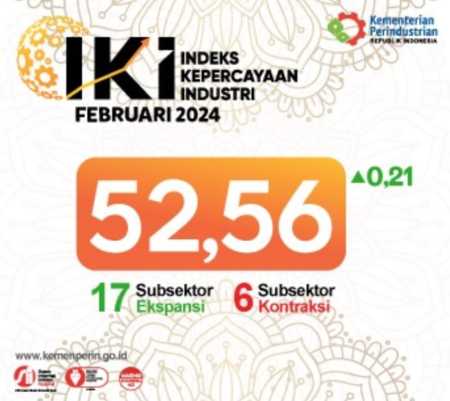Measuring the Risk and Productivity of Indonesian Debt
By : Ridwan And Aldi Firhand. A | Saturday, May 19 2018 - 22:20 IWST

BI Governor Agus Martowardojo with President Jokowi and Finance Minister Sri Mulyani (Foto Rizki Meirino)
INDUSTRY.co.id - Jakarta, Indonesia's foreign debt as of April 2018 has reached Rp4,180 trillion, up 14% from April 2017. But the dogma that debt is still under 60% of GDP is being sued.
The government repeatedly explained to the public that there is nothing wrong to increase the debt. Of course it is accompanied by a picture of toll roads, bridges and dams that are being built through debt. The magic spell of old tapes is always spinning, "If you owe for infrastructure development then the debt is actually productive debt".
Then how should measuring risk and debt productivity? The simplest thing is to measure debt to GDP.
In the State Finance Law No.17 of 2003 stated that the maximum limit of debt is 60% to GDP. Without a variety of interpretations, the conclusion that the Government debt as of April 2018 is still Rp4,180 trillion then equal to 29.8% of GDP alias far below the 60% threshold.
But the development of debt seems to have to be updated again, the debt limit to GDP becomes too simple. The facts in Europe when the debt crisis of 2013-2015 became the turning point of doubt between debt limit to GDP.
Some countries in Europe that have a debt ratio above 100% such as Italy and Belgium are not included in the IMF Troika bailout program. While countries such as Ireland and Spain in 2008 have a debt ratio of 43% and 39% entered into the list of IMF patients who must be helped.
Not that the ratio of debt irelevan, but must be equipped with other indicators to read debt is not oversimplified (too simplifying).
Indonesia is also often compared to Japan. Yes indeed Japan has a debt ratio above 200%. But more than 50% of Japan's debt is held by the Central Bank of Japan. While the remaining 30% is held by residents or residents of Japan.
This means the Japanese population and the Central Bank of Japan are lending to the Government.
Then what are the benefits? As the global economy worsens and leads to panic sellout on the bond market, the Government of Japan is not too worried. Housewives and employees who buy bonds just melt the debt but the money does not run out of the country, but spins around in the Japanese economy.
The conditions in Indonesia are quite different. As much as 38.7% of Government bonds are held by foreign investors. That is, global conditions such as the trend of interest rate increase Fed rate, geopolitical instability, and the wave of protectionism developed countries are very sensitive to the bond market in Indonesia.
Because the financial market is very shallow, once external shocks occur, the foreign funds in the bonds are obscured. So no wonder, why the rupiah could drop to almost touching 14,200 on May 18 this despite BI has raised interest rate 25 bps.
Another indicator that should be compared is the tax ratio of each country is different. It should be noted and understood that debt is not paid using GDP. So the debt-to-GDP ratio is actually just a general overview.
In fact debt is paid with tax revenues. While the ratio of tax to GDP (tax ratio) in Indonesia in 2017 only 9%. Do not go far compared with developed countries. With the State in ASEAN alone our tax ratio is one of the lowest, Malaysia already 14.2% and Thailand 15.7%.
If our tax revenues are still sluggish because the average realization only grew 4% in the last 2 years, how to pay the debt plus its interest? The emergence of what is called the primary balance deficit, the total state revenue minus expenditure, excluding debt interest payments. This means that if a deficit occurs, the debt is repaid through the issuance of new debt.
Since 2012 the primary balance deficit was recorded at Rp52.7 trillion. The number of 2017 to Rp178 trillion. Dig a hole closing hole, but the current hole is deeper.
Read Also
Today's Industry

Rabu, 28 Februari 2024 - 12:47 WIB
Carsurin and NBRI Strengthen Strategic Alliance to Propel Indonesia’s EV Industry
PT Carsurin Tbk ("Carsurin") and the National Battery Research Institute ("NBRI") are pleased to announce the signing of a pivotal Strategic Alliance Agreement (SAA), marking a significant advancement…

Rabu, 21 Februari 2024 - 08:43 WIB
Gov’t to Continue Disbursing Rice Assistance
President Joko “Jokowi” Widodo has ensured that the Government will continue rolling out the rice assistance program for low-income families. The President made the statement when handing…

Rabu, 21 Februari 2024 - 08:40 WIB
Bapanas Head Ensures Availability of Rice Stock Ahead of Ramadan
The National Food Agency (Bapanas) has ensured the availability of rice for the fasting month of Ramadan and Eid al-Fitr 1445 Hijri/2024 CE. “We believe that there is enough rice for the fasting…

Rabu, 21 Februari 2024 - 08:23 WIB
Receives Chairman of Jababeka (KIJA), Menpora Dito Ready to Support the Development of Sports SEZs
Chairman of PT Jababeka Tbk (KIJA), Setyono Djuandi Darmono met the Minister of Youth and Sports of the Republic of Indonesia (Menpora RI) Dito Ariotedjo at the Kemenpora RI Office, Senayan,…

Senin, 19 Februari 2024 - 17:39 WIB
The Indonesian Embassy in Cairo Receives Aid for Palestine
The Indonesian Embassy in Cairo welcomes the Radjiman Wedyodiningrat Warship (RJW-992) which arrived at the Al Arish Port, North Sinai Province of Egypt at 8.00 A.M. Cairo local time (13/02).…
















News Comment